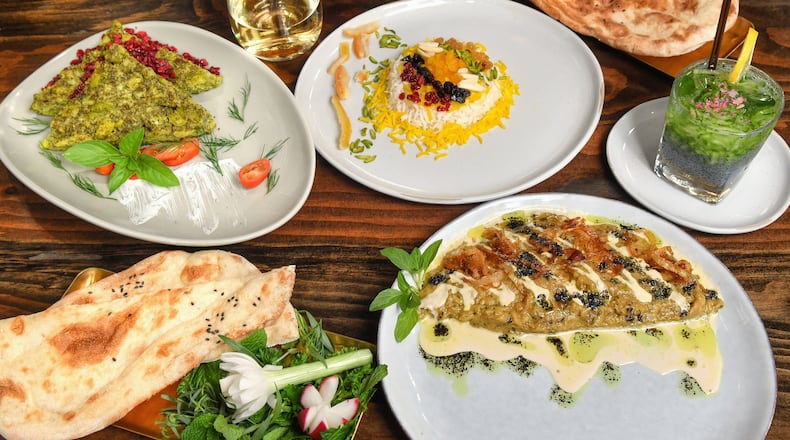Atlanta has its share of Persian restaurants, beloved for their rice dishes, flatbreads, platters of herbs and cheese, and kebabs. When Max Lotfi and his wife, Arezoo Armaghan, were ready to open Persian Basket Kitchen & Bar in Johns Creek, they knew they wanted to do something different. They wanted to offer dishes more typical of the stews and other braised dishes that would be served in a Persian home.
Make no mistake, there are many rice dishes available, and a number of appetite teasers such as local goat cheese plates served with quince jam and naan, but hearty dishes of succulent meats are a menu mainstay.
The menu is the creation of Lotfi and his wife, working with his longtime chef de cuisine, Peyman Rostmi, and Homa Ghasemi, the general manager and pastry chef who is responsible for the restaurant’s jams, ice creams, pastries and fruit-based drinks.
Credit: Chris Hunt
Credit: Chris Hunt
“Most homes don’t have a grill. When we want to have kebabs, we go to a restaurant. At home, we would saute meat, then put it in the oven to braise,” said Lotfi. And so the menu includes Ghormeh Sabzi, a stew of lamb and red kidney beans served over basmati rice, and beef stroganoff. Yes, beef stroganoff.
Lotfi says the stroganoff reflects the crossroads culture of Iraq, a country sitting between Syria and Jordan to the west, Iran to the east, Saudi Arabia to the south, and Turkey and the former states of the Soviet Union to the north.
“We prepare a dish from northern Iran, Akbar Joojeh, which we describe on our menu as ‘duck confit’ since that’s a preparation our clients may be familiar with. But it’s served with a pomegranate reduction.”
There’s braised lamb shank on the menu because in the Persian home kitchen, the meats would always be cooked bone-in. “Stews are always made with bone-in meat and especially with lamb shanks, many people like to eat the bone marrow because it’s cooked so well. It’s part of our culture.”
He reflects on the combination of Arabic, Israeli, Indian and Asian influences on Persian cuisine. “I think there’s more Asian influence than many people think. The Chinese, the Moguls, the influence of the Ottoman Empire and the Romans, from Europe to the Mediterranean coast.”
Lotfi offered our readers adaptations of three dishes that are staples of the Persian Basket Kitchen & Bar menu. Kashke Bademjaan is a mash of roasted eggplant that differs from the familiar baba ghanoush with the way it’s prepared and the addition of mint to the eggplant.
Morasa Rice is an example of the high art of Persian rice cookery with its fluffy grains of rice studded with dried fruit and nuts and garnished with a saffron and rose water-flavored rice topping.
Koko Shevid Baghali is a simple frittata that gets its richness from creamy fresh fava beans beaten in with the eggs.
If you’re concerned about finding ingredients for these Persian dishes, Lotfi and Armaghan established an online store, persianbasket.com. There they sell more than a dozen varieties of rice, 40 varieties of pickles, nuts of every description including fresh raw walnuts, and yogurt products including yogurt soda. Just browsing the online shelves is a virtual tour of Persia and the countries that have influenced its food.
RECIPES
Max Lotfi of Persian Basket Kitchen & Bar offers three recipes that represent some of the most typical dishes you’d find in an Iranian kitchen. All are meatless and perfect for a late summer/early fall lunch or dinner.
Credit: Chris Hunt
Credit: Chris Hunt
Morasa Rice
This dish is also known as jeweled rice for its brilliant yellow rice garnish and the bits of dried fruit and nuts. Lotfi says the barberries are a non-negotiable ingredient, essential for the tartness they provide. If using saffron threads, he says be sure to crush them to make a powder before stirring them into the boiling water.
Cooking rice is an art form in Persia with a process that results in rice in which every grain is separated and is light and fluffy. It’s worth following this method precisely to get the best results.
Credit: Chris Hunt
Credit: Chris Hunt
Koko Shevid Baghali (Fava Beans and Dill Frittata)
Fava beans may not be the easiest beans to find, but they are essential to this dish. And preparing them is truly a labor of love. First the beans are released from their pods, then each individual bean must be peeled to remove the lighter green outer peel. Now you’re ready to prepare them. We found that 1 pound of fresh fava beans in the pod yielded only 3/4 cup of beans. But when cooked, the delicious creamy beans are worth the effort.
Fresh fava beans are available from persianbasket.com with a 3-pound minimum order, and generally in season nine months out of the year. You may also find them at other large international markets.
milligrams sodium.
Credit: Chris Hunt
Credit: Chris Hunt
Kashke Bademjaan (Eggplant Dip)
This is a recipe that’s easy to scale up if you have more guests to feed.
The kashk is available at persianbasket.com but Lotfi says you could substitute strained fat-free Greek yogurt if you prefer.
Read more stories like this by liking Atlanta Restaurant Scene on Facebook, following @ATLDiningNews on Twitter and @ajcdining on Instagram.
About the Author
The Latest
Featured






